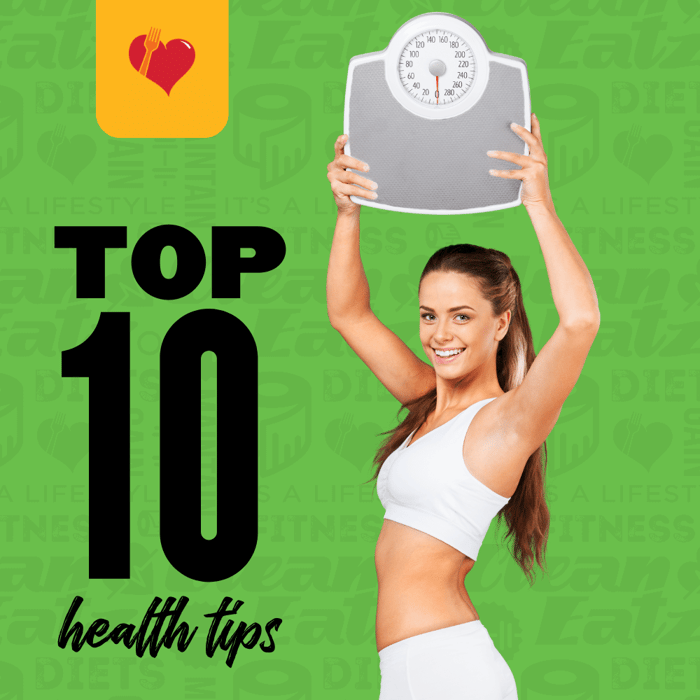Last updated: September 11, 2025
Top 10 Health Tips (That Actually Fit a Busy Life)
Quick answer: Better health comes from a few simple habits done consistently—protein-forward meals, daily movement, strength training, good sleep, and calm routines. Use the tips below to build a week that works in real life.
1) Build Balanced Plates (Most of the Time)
- Formula: 1 palm (4–6 oz) lean protein + 1–2 cups vegetables + a measured smart carb (½–1 cup cooked rice/potatoes/whole grains or 1–2 slices bread) + 1–2 tsp added fats.
- Make it easy: plan 1–2 go-to breakfasts, 2–3 lunches, and 3–4 dinners you can repeat.
2) Anchor Protein at Each Meal
- Target: about 20–40 g protein per meal (Greek yogurt, eggs, chicken, salmon, shrimp, beans, tofu).
- Why: supports fullness, recovery, and body composition when losing weight.
3) Choose Fiber-Rich Carbs
- Often: fruits, beans/lentils, oats, whole-grain bread/pasta, potatoes/rice in measured portions.
- Daily aim: roughly 25–35 g fiber (adjust to comfort, drink water).
4) Hydrate Without Liquid Sugar
- Simple rule: a glass of water with each meal/snack; add more when it’s hot or you’re training.
- Skip the creep: limit sugary coffees, juices, and large alcohol pours that silently add calories.
5) Walk More, Every Day
- Baseline: add 2,000–3,000 steps to your current average; many people feel great around 7–10k.
- Stack it: short walks after meals help digestion and blood sugar.
6) Strength Train 2–3x/Week
- Focus: full-body sessions (squat/hinge/push/pull/carry) for 30–45 minutes.
- Result: more strength, better shape, and easier weight maintenance.
7) Add Cardio You Enjoy
- Goal: around 150 minutes/week of moderate effort (or shorter vigorous sessions).
- Options: brisk walking, cycling, elliptical, swimming, classes—whatever you’ll repeat.
8) Sleep Like It’s a Habit
- Target: about 7–9 hours/night.
- Wind-down: dim lights, consistent bedtime, screens off 30–60 minutes before bed.
9) Keep Stress Tools Handy
- One-minute reset: slow nasal breathing—inhale 4s, exhale 6–8s for 6–10 cycles.
- Daily rhythm: daylight exposure, short breaks, a quick walk, or journaling.
10) Make Your Environment Do the Work
- Visibility: keep fruit, yogurt, and ready proteins front-and-center; store treats out of sight.
- Batch & plan: schedule workouts; prep 2–3 protein choices for the week.
Weekly Starter Plan (Copy/Paste)
- Meals: protein + veg + measured carbs at lunch/dinner; simple breakfast you’ll repeat.
- Training: M/W/F strength (30–45 min) + 2–3 cardio or long walks.
- Steps: add 2–3k to your current average; short post-meal walks.
- Sleep: consistent lights-out time; phone outside the bedroom if possible.
Make Nutrition the Easy Part
Remove the guesswork and keep protein on target with our Weight-Loss Meal Plan. Want to customize? Use Build-a-Meal Plan, and stock quick options from our High-Protein Box and Overnight Oats.
FAQs
What are the top 10 health tips?
Balanced plates, protein at each meal, fiber-rich carbs, hydrate smart, daily walking, 2–3 strength sessions, enjoyable cardio, 7–9 hours sleep, simple stress tools, and a supportive environment.
How much protein do I need?
A practical target is about 20–40 g per meal. Adjust to your appetite, training, and goals.
How much should I exercise weekly?
Many people do well with 2–3 strength sessions plus around 150 minutes of moderate cardio (or shorter vigorous sessions).
Is walking enough?
Walking is excellent for health and weight control—especially when steps increase and you add a bit of strength training.
What if I’m overwhelmed?
Start with two habits: a daily 10–15 minute walk and a protein-forward breakfast. Layer one new habit every week.
Disclaimer: This article is for general information only and isn’t medical advice. Personalize with your clinician if you have medical conditions or specific needs.




